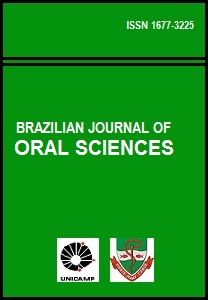Abstract
Proximal cavity lesions are difficult to diagnose and are also hard to examine due to their location. Radiographic examination and teeth separation are resources used to help in caries diagnosis. The aim of this study was to evaluate, in different professional experience levels, the effectiveness of clinical and radiographic examinations in diagnosing proximal cavities, comparing lesion depth considered in these examinations to histological examinations. Thirty nine human teeth were used, 20 premolars and 19 molars, with clinical alterations on one proximal surface, such as lesions with either white or brownish stains and small cavitations which showed no clinical signs on the occlusal face, causing the professional insecurity in performing an accurate diagnosis as well as appropriate treatment. Samples were made using x-ray interproximal technique. Forty professionals of different experience levels performed clinical and radiographic examinations of the samples by filling out a form after classifying lesions depth. The samples were later sectioned for a histological analysis. Results showed that there was great variability on answers to examinations, with a low agreement percentage among examiners. After concluding all evaluated examinations, the examiners were not able to come up with an accurate diagnosis of lesions conditions on proximal cavities. The rate of cavitation was greater in lesions found on the external half of dentine, surpassing the amelodentinal limit, and an agreement percentage to conventional and digital x- ray examinations were equivalent.References
Akpata ES, Farid MR, al-Saif K, Roberts EA. Cavitation at radiolucent areas on proximal surfaces of posterior teeth. Caries Res. 1996; 30: 313-6.
Burke FJT, Wilson NHF. When caries is caries, and what should we do about it? Quintessence Int. 1998; 29: 668-71.
Ratledge DK, Kidd EA, Beighton DA. A clinical and microbiological study of approximal carious lesions. Part 1: The relationship between cavitation, radiographic lesion depth, the site-specific gingival index and the level of infection of the dentine. Caries Res. 2001; 35: 3-7.
Ekstrand K, Bruun G, Bruun M. Plaque and gingival status as indicators for caries progression on approximal surfaces. Caries Res. 1998; 32: 41-5.
Vecchio TJ. Pedictive value of a single diagnostic test in um selected populations. N Eng J Med. 1966; 275: 1171-3.
Hintze H, Wenzel A, Danielsen B. Behaviour of approximal carious lesions assessed by clinical examination after tooth separation and radiography: a 2.5-year longitudinal study in young adults. Caries Res. 1999; 33: 415-22.
Feldens CA, Tovo MF, Kramer PF, Feldens EG, Ferreira SH, Finkler M. An in vitro study of correlation between clinical and radiographic examinations of proximal carious lesions in primary molars. J Clin Pediatr Dent. 2003; 27: 143-7.
Kidd EAM, Banerjee A, Ferrier S, Longbottom C, Nugent Z. Relationships between a Clinical-Visual Scoring Sistem and two histological techniques: a laboratory study on occlusal and approximal carious lesions. Caries Res. 2003; 37: 125-9.
Sanden E, Koob A, Hassfeld S, Staehle HJ, Eickholz P. Reliability of digital radiography of interproximal dental caries. Am J Dent. 2003; 16: 170-6.
Syriopoulos K, Sanderink GC, Velders XL, van der Selt PF. Radiographic detection of approximal caries: a comparison of dental films and digital imaging systems. Dentomaxillofac Radiol. 2000; 29: 312-8.
Thylstrup A, Bille J, Qvist V. Radiographic and observed tissue changes in approximal carious lesions at time of operative treatment. Caries Res. 1986; 20: 75-84.
Tan PL, Evans RW, Morgan MV. Caries, bitewings, and treatment decisions. Aust Dent J. 2002; 47: 138-41.
Meneghim MC, Assaf AV, Zanin L, Kozlowski FC, Pereira AC, Ambrosano GM. Comparison of diagnostic methods for dental caries J Dent Child. 2003; 70: 115-9.
Deep P, Petropoulos D. Effect of illumination on the accuracy of identifying interproximal carious lesions on bitewing radiographs J Can Dent Assoc. 2003; 69: 444-6.
The Brazilian Journal of Oral Sciences uses the Creative Commons license (CC), thus preserving the integrity of the articles in an open access environment.

